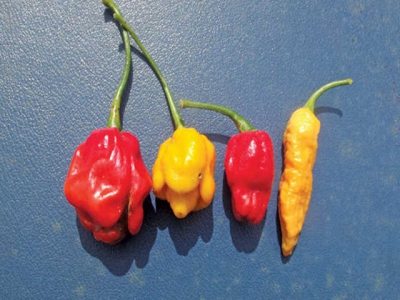Understanding chilli pungency

The pungency or ‘burn’ of a chilli is the result of a complex combination of capsaicinoids that have a different effect depending on which are present and in what combination.
Some super- hot modern varieties under development.
As a chilli breeder, I have hundreds of varieties under trial. When evaluating the pungency of each, my mouth soon becomes so numb as to render it useless for further taste tests.
As a result, I have a number of other people tasting chillies for me. They remark on ‘delayed burn’, ‘sharp burn’, ‘persistent burn’, and so on.
A nod and a smile usually indicate relatively low pungency. Coughing tells me the chilli is quite pungent, while hiccoughs are a sign of high pungency.
Rapid spitting, together with the other indicators, plus watering of the eyes and impaired speech point to some of the highest levels of pungency!
Pungency is measured in Scoville heat units (SHU) This scale was developed in the USA in 1912 by pharmacist Wilbur Scoville.
He would take a drop of chilli juice and dilute it in sugar water. The number of drops of syrup that needed to be added until a panel of five judges could no longer detect any ‘burn’ became the measure of pungency.
In other words, a chilli variety with a SHU of 5 000 means that it took 5 000 drops of syrup before the judges could no longer taste any pungency. These days, high- performance liquid chromotology has replaced humans when it comes to ‘tasting’. The reading derived by this method is multiplied by 15 to give the approximate SHU.
Not always the same
The same variety will not always have the same rating, however. Climate and soil condition have a strong influence on pungency.
Hot weather, for example, increases pungency. Even with an open pollinated variety, you need to be very careful when selecting plants for seed increase, as there can be quite significant differences between plants that are identical in all other respects.
At one time, the variety Red Savina held the Guinness World Record for the hottest chilli in the world with a reading of 577 000 SHU. Then reports started filtering through from India that a variety measuring over 900 000 SHU was being grown there.
A sceptical Prof Paul Bosland, who heads the Chilli Pepper Institute at New Mexico State University, acquired this variety, called Naga Jolica, and planted it in a greenhouse together with the world record holder.
In this case, Red Savina only registered 400 000 SHU, while Naga Jolica measured over 1 000 000 SHU. Today there are varieties such as Carolina Reaper that measure 1 500 000 SHU plus.
Who knows where it will end? Perhaps one day we’ll have to market some chillies with a health warning on the packet!
Some species such as Capsicum pubescens contain an entirely different set of capsaicinoids that may have the same pungency reading as another species, but produce a different reaction on the palate.
Apart from the intensity of the burn, there is the aftertaste. This may linger for some time and provide a wonderful, satisfying sensation – the product of a combination of capsaicinoids and flavour.
With chilli consumption on the increase, perhaps we’ll develop a taste evaluation protocol, as with wine tasting!
Our Indian population prefers thin-walled, highly pungent varieties, but I’ve come across many people who will not eat chillies at all as they are not used to the burn.
Marketing milder varieties
Perhaps farmers should address this issue and market milder varieties labelled accordingly to tap into this very large sector of our population. One of my clients, a fairly large chilli grower, found a low pungency variety in his trials and, for a while, marketed it as a ‘chilli for sissies’.
Supermarkets and food magazines can contribute to developing a market to suit all tastes so that nobody is excluded from this healthy and tasty spice.
We need to get away from the macho culture of chilli consumption and become more diverse and practical. Correct marketing and labelling can open many doors presently shut to chilli growers.
Related news
Tools

Phối trộn thức ăn chăn nuôi

Pha dung dịch thủy canh

Định mức cho tôm ăn

Phối trộn phân bón NPK

Xác định tỷ lệ tôm sống

Chuyển đổi đơn vị phân bón

Xác định công suất sục khí

Chuyển đổi đơn vị tôm

Tính diện tích nhà kính

Tính thể tích ao



 Producing capsicum seedlings in soil beds
Producing capsicum seedlings in soil beds  Chillies, how to make the right choices
Chillies, how to make the right choices